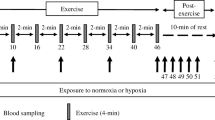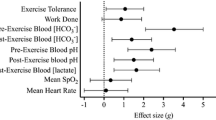Abstract
The effect of acute hypoxia on blood concentration of ammonia ([NH3]b) and lactate ([la−]b) was studied during incremental exercise (IE), and two-step constant workload exercises (CE). Fourteen endurance-trained subjects performed incremental exercise on a cycle ergometer under normoxic (21% O2) and hypoxic (10.4% O2) conditions. Eight endurance-trained subjects performed two-step constant workload exercise at sea level and at a simulated altitude of 5000 m (hypobaric chamber, PB=405 Torr; Po2=85 Torr) in random order. In normoxia, the first step lasted 25 minutes at an intensity of 85% of the individual ventilatory anaerobic threshold (ATvent, ind) at sea level. This reduced workload was followed by a second step of 5 minutes at 115% of their ATvent, ind. This test was repeated into a hypobaric chamber, at a simulated altitude of 5,000 m. The first step in hypoxia was at an intensity of 65% of ATvent, ind., whereas workload for the second step at simulated altitude was the same as that of the first workload in normoxia (85% of ATvent, ind). During IE, [NH3]b and [la−]b were significantly higher in hypoxia than in normoxia. Increases in these metabolities were highly correlated in each condition. The onset of [NH3]b and [la−]b accumulation occurred at different exercise intensity in normoxia (181W for lactate and 222W for ammonia) and hypoxia (100W for lactate and 140W for ammonia). In both conditions, during CE, [NH3]b showed a significant increase during each of the two steps, whereas [la−]b increased to a steady-state in the initial step, followed by a sharp increase above 4 mM·L−1 during the second. Although exercise intensity was much lower in hypoxia than in normoxia, [NH3]b was always higher at simulated altitude. Thus, for the same workload, [NH3]b in hypoxia was significantly higher (p<0.05) than in normoxia. Our data suggest that there is a close relationship between [NH3]b and [la−]b in normoxia and hypoxia during graded intensity exercises. The accumulation of ammonia in blood is independent of that of lactate during constant intense exercise. Hypoxia increases the concentration of ammonia in blood during exercise.
Resumen
Se estudia el efecto de la hipoxia aguda en las concentraciones de amonio ([NH3]b) y lactato ([la−]b) en sangre mediante dos tests diferentes de ejercicio: con aumento progresivo de la carga (IE) y con carga constante en dos escalones (CE). Catorce corredores de fondo realizaron el test IE en un cicloergómetro bajo condiciones de normoxia (21% O2) e hipoxia (10,4% O2), comenzando con una carga de 100W con aumentos progresivos de 25W cada 4 minutos hasta el agotamiento. Otros ocho corredores de fondo realizaron el test CE de un escalón de 25 min seguido de otro de 5 min, a nivel del mar y a una altitud simulada de 5000 m (en cámara hipobárica; PB=405 Torr, PO2=85 Torr) en un cicloergómetro. A nivel del mar, el primer escalón se realizaba a intensidad 85% del umbral anaeróbico ventilatorio individual (ATvent, ind), y sin interrupción, el segundo escalón se realizaba a intensidad 115% del ATvent, ind. En hipoxia, el primer escalón se realizaba a intensidad 65% del ATvent, ind, mientras que la carga para el segundo escalón era la misma que la del primer escalón en normoxia (85% del ATvent, ind). Durante el test IE, la [NH3]b y [la−]b son significativamente mayores en hipoxia que en normoxia, con estrecho paralelismo entre ambos metabolitos tanto en normoxia como en hipoxia. El inicio de la acumulación de [NH3]b y [la−]b ocurre a intensidades de ejercicio diferentes en normoxia (181 W para el lactato y 222 W para el amonio) e hipoxia (100 W para el lactato y 140 W para el amonio). Durante el test CE, la [NH3]b aumenta de forma significativa y gradual durante cada uno de los dos escalones, mientras que [la−]b aumenta sólo ligeramente durante el primer escalón, seguido de un marcado aumento, por encima de los 4 mM·L−1, durante el primer escalón, seguido de un marcado aumento, por encima de los 4 mM·L−1, durante el segundo, en normoxia e hipoxia. Aunque la intensidad del ejercicio es menor en hipoxia que en normoxia, la [NH3]b es siempre superior en hipoxia, de modo que, a igual carga, la [NH3]b en hipoxia es significativamente mayor (p<0,05) que en normoxia. Nuestros datos sugieren la existencia de una estrecha relación entre [NH3]b y [la−]b en normoxia e hipoxia para ejercicios de intensidad progresiva, mientras que la [NH3]b es independiente de [la−]b durante un ejercicio intenso y constante. La hipoxia incrementa la concentración de amonio en sangre durante el ejercicio.
Similar content being viewed by others
References
Banister, E. W. and Cameron, B. J. C. (1990):Int. J. Sports. Med.,11, 129–142.
Beaver, W. L., Wasserman, K. and Whipp, B. J. (1986):J. Appl. Physiol.,60, 2020–2027.
Buono, M. J., Clancy, T. R. and Cook, J. R. (1984):J. Appl. Physiol.,57, 135–139.
Dudley, G. A. and Terjung, R. L. (1985):Am. J. Physiol.,248, 37–42.
Graham, T. E., Pedersen, P. K. and Saltin, B. (1987):J. Appl. Physiol.,63, 1457–1462.
Graham, T. E., Turcotte, L. P., Kiens, B. and Richter, E. A. (1995):J. Appl. Physiol.,78, 725–735.
Grassi, B., Ferretti, G., Kayser, B., Marzorati, M., Colombini, A., Marconi, C. and Cerretelli, P. (1995):J. Appl. Physiol.,79, 331–339.
Heck, H., Mader, A., Hess, G., Mücke, S., Müller, R. and Hollmann, W. (1995):Int. J. Sports. Med.,6, 117–130.
Hellsten, Y., Richter, E. A., Kiens, B. and Bansbo, J. (1999):J. Physiol.,520, 909–920.
Ibañez, J., Rama, R., Riera, M., Prats, M. T. and Palacios, L. (1993):Eur. J. Appl. Physiol.,67, 7–13.
Jacobs, I. (1986):Sport Med.,3, 10–25.
Koistinen, P., Takala, T., Martikkala, V. and Leppäluoto, L. (1995):Int. J. Sports Med.,16, 78–81.
Lowenstein, J. M. (1990):Int. J. Sports Med.,11, 37–46.
Pagés, T., Murtra, B., Ibañez, J., Rama, R., Callis, A. and Palacios, L. (1994):J. Sports Med. Physic Fitness.,34, 351–356.
Roeykens, J., Magnus, L., Rogers, R., Meeusen, R. and De Meirleir, K. (1998):Int. J. Sports Med.,19, 26–31.
Snow, R. J., Carey, M. F., Stathis, C. G., Febbraio, M. and Hargreaves, M. (2000):J. Appl. Physiol.,88, 1576–1580.
Taylor, A. D. and Bronks, R. (1996):Eur. J. Appl. Physiol.,73, 121–129.
Tullson, P. C. and Terjung, R. L. (1991):Exerc. Sport Sci. Rev.,19, 507–537.
Urhausen, A. and Kindermann, W. (1992):Eur. J. Appl. Physiol.,65, 209–214.
Wagenmakers, A. J. M. (1992):Int. J. Sports Med.,13, 110–113.
Weltman, A. (1995):Human Kinetics, 1–117.
Young, P. M., Rock, P. B., Fulco, C. S., Trad, L. A., Forte, V. A., Jr. and Cymerman, A. (1987):J. Appl. Physiol.,63, 758–764.
Author information
Authors and Affiliations
Corresponding author
Rights and permissions
About this article
Cite this article
Casas, H., Murtra, B., Casas, M. et al. Increased blood ammonia in hypoxia during exercise in humans. J. Physiol. Biochem. 57, 303–312 (2001). https://doi.org/10.1007/BF03179824
Received:
Issue Date:
DOI: https://doi.org/10.1007/BF03179824




